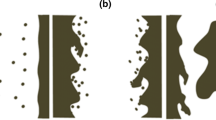Abstract
Safe pipeline transportation of carbon dioxide is a critical issue in the developing field of carbon capture and storage technology. Inadequate fluid thermo- and regimes for on- and offshore transport through high-pressurized pipelines can induce pipe material obsolescence or even pipeline rupture. In such cases, CO2 (Carbon dioxide) will be released and dispersed in the ambient medium. The dispersion is influenced by the total amount of released fluid, jet pressure and direction, the released concentrations, leakage hole size, ambient material properties and is also affected by the dynamical conditions of the environmental medium. The goal of this study is the hydrodynamical characterization of carbon dioxide jet expansion and dispersion in the ambient atmosphere in case of onshore pipeline accidental leaks. Numerical simulations were carried out by means of a 3D turbulent CFD (computational fluid dynamics) code which includes multi-component flow treatment. The influence of the jet release pressure and size of the leakage hole on harmful CO2 concentration distances will be analyzed.














Similar content being viewed by others
References
Biausser B, Grilli ST, Fraunié P (2003) Numerical simulations of three-dimensional wave breaking by coupling of a VOF method and a boundary element method. Proc Int Offshore Polar Eng Conf 333–339
Bratfos HA, Leinum BH, Torbergsen LE, Saugerud OT (2007) Challenges to the pipeline transportation of dense CO2. J Pipeline Eng 6(3):161–172
CCS Guidelines (2008) Guidelines for Carbon Dioxide capture, transport, and storage. World Resources Institute, Washington, DC:
Chen CJ, Rodi W (1980) Vertical turbulent buoyant jets: a review of experimental data. Pergamon Press, Oxford
Cherubini Y, Cacace M, Scheck-Wenderoth M, Moeck I, Lewerenz B (2013) Controls on the deep thermal field: implications from 3D numerical simulations for the geothermal research site Gro Schnebeck. Environ Earth Sci. doi:10.1007/s12665-012-2212-z
CO2PIPETRANS Phase 2 JIP, 1st Release Of Model Validation Data, DNV Project Number: PP014941 (2012)
Djeridane T, Amielh M, Anselmet F, Fulachier L (1996) Velocity turbulence properties in the near-field region of axisymmetric variable density jets. Phys Fluids 8(6):1614–1630
Ensuring safe use of carbon capture and storage in Europe, DG Climate Action, European Union (2012)
Element Energy Limited (2010) CO2 pipeline Infrastructure: an analysis of global challenges and opportunities, Final Report for International Energy Agency Greenhouse Gas Programme 27/04/2010
Ji XB, Zhao W, Kang ES, Zhang ZH, Jin BW (2011) Carbon dioxide, water vapor, and heat fluxes over agricultural crop field in an arid oasis of Northwest China, as determined by eddy covariance. Environ Earth Sci, 64: 619–629
Kaiser BO, Cacace M, Scheck-Wenderoth M (2013) 3D coupled fluid and heat transport simulations of the Northeast German Basin and their sensitivity to the spatial discretization: Different sensitivities for different mechanisms of heat transport. Environ Earth Sci. doi:10.1007/s12665-013-2249-7
Koornneef J, Spruijt M, Molag M, Ramirez A, Faaij A, Turkenburg W (2009) Uncertainties in risk assessment of CO2 pipelines. Energy Procedia 1: 1587–1594
Kruse H, Tekiela M (1996) Calculating the consequences of a CO2 -pipeline rupture. Energy Conver Mgmt 37(68): 1013–1018
Mazzoldi A, Hill T, Colls JJ (2008) CO2 transportation for carbon capture and storage: sublimation of carbon dioxide from a dry ice bank. Int J Greenh Con 2: 210–218
Mazzoldi A, Hill T, Colls JJ (2008) CFD and Gaussian atmospheric dispersion models: a comparison for leak from carbon dioxide transportation and storage facilities. Atmos Environ 42: 8046–8054
Mazzoldi A, Hill T, Colls JJ (2009) A consideration of the jet-mixing effect when modelling CO2 emissions from high pressure CO2 transportation facilities. Energy Procedia 1: 1571–1578
Mazzoldi A, Hill T, Colls JJ (2011) Assessing the risk for CO2 transportation within CCS projects. CFD model. Int J Greenh Con 5: 816–825
Molag M, Dam C (2011) Modelling of accidental releases from a high pressure CO2 pipelines. Energy Procedia 4: 2301–2307
Neele F, Koenen M, van Deurzen J, Seebregts A, Groenenberg H, Thielemann T (2011) Large-scale CCS transport and storage networks in North-west and Central Europe. Energy Procedia 4: 2740–2747
Noack V, Scheck-Wenderoth M, Cacace M, Schneider M (2013) Influence of moving fluids on the regional thermal field: results from 3D numerical modelling for the area of Brandenburg (North German Basin). Environ Earth Sci. doi:10.1007/s12665-013-2438-4
OpenFOAM (2012) The open source CFD toolbox, User guide version 2.1.1
Schulz FT, Glawe C, Kerstein AR, Schmidt H (2013) Toward modeling of CO2 multi-phase flow patterns using a stochastic multi-scale approach. Environ Earth Sci. doi:10.1007/s12665-013-2461-5
van den Bosch CJH, Weterings RAPM (2005) Methods for the calculation of physical effects - due to releases of hazardous materials (liquids and gases), Yellow Book
Vendrig M, Sponge J, Bird A, Daycock J, Johnsen O (2003) Risk analysis of geological sequestration of carbon dioxide, report no. COAL 246, DTI/pub URN 03/1320, Department of Trade and Industry (DTI), London, UK
Vianello C, Macchietto S, Maschio G (2012) Conceptual models for CO2 release and risk assessment: a review. Chem Eng Trans 26:573–576
Wang P, Fröhlich J, Michelassi V, Rodi W (2008) Large-eddy simulation of variable-density turbulent axisymmetric jets. Int J Heat Fluid Flow 29: 654–664
Witlox HWM (2012) Data review and Phast analysis (discharge and atmospheric dispersion) for BP DF1 CO2 experiments, Det Norske Veritas
Acknowledgments
This work was supported by the German Federal Ministry of Education and Research in the framework of the project GeoEn Verbundvorhaben GeoEnergie FKZ: 03 G 0767 B.
Author information
Authors and Affiliations
Corresponding author
Rights and permissions
About this article
Cite this article
Herzog, N., Gorenz, P. & Egbers, C. CFD modeling of high-pressurized CO2 released from onshore pipeline leakages. Environ Earth Sci 70, 3749–3759 (2013). https://doi.org/10.1007/s12665-013-2536-3
Received:
Accepted:
Published:
Issue Date:
DOI: https://doi.org/10.1007/s12665-013-2536-3




